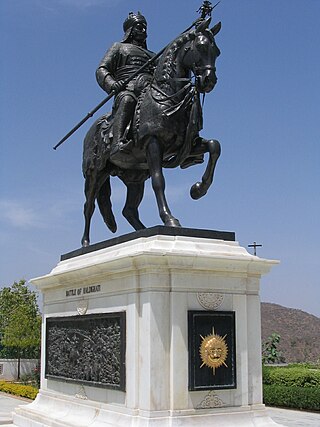Top Qs
Timeline
Chat
Perspective
Rana (title)
Indian honorary title From Wikipedia, the free encyclopedia
Remove ads
Rana (IAST: Rāṇā, राणा) is a historical royal title from the Indian subcontinent, where it is today used as a hereditary name. "Rana" was formerly used as a title of martial sovereignty by Rajput kings in India.[1] The term derives from the Sanskrit title "Rāṇaka".[2]

Rani is the title for the wife of a rana or a female monarch. It also applies to the wife of a raja. Compound titles include rana sahib, ranaji, raj rana, rana bahadur, and maharana.
Remove ads
Usage in the Indian subcontinent
Summarize
Perspective


"Rana" was formerly used as a title of martial sovereignty by Rajput kings in India.[1] Sisodia rulers of Mewar used the title of Mahārāṇā (महाराणा) extensively in their royal charters. Today, members of some Rajput clans in Indian subcontinent use it as a hereditary title. In Pakistan, mostly Muslims—but also some Hindus in Sindh (present-day Pakistan)—use it as a hereditary title.[3] Amarkot, a state in Sindh, has a Hindu Thakur Sodha Rajput ruler who uses the title.[4]
In the 16th century, Rana Prasad, the monarch of Amarkot, gave refuge to the Mughal prince Humayun and his wife, Hamida Banu Begum, who had fled from military defeat at the hands of Sher Shah Suri. Their son Akbar was born in the fort of the Rana of Amarkot.[5]

The head of the Kunwar nobles of Nepal, Jung Bahadur Kunwar, took the title of Rana(ji) and Shree Teen Maharaja after consolidation of his post of Prime Minister of Nepal. This dynasty controlled administration of the Kingdom of Nepal from 1846 until 1951, reducing the Shah monarch to a figurehead and making Prime Minister and other government positions hereditary.[6][7]
Remove ads
As a title
As a title, Rana is used by different Rajput clans across India, Pakistan and Nepal. In India and Nepal, they are predominantly Hindus.[8][9][10]
Rana rule in Nepal
The Rana dynasty of Nepal was a Chhetri[note 1] dynasty that[16] imposed authoritarianism in the Kingdom of Nepal from 1846 until 1951, reducing the Shah monarch to a figurehead and making the Prime Minister and other government positions held by the Ranas hereditary. On 15 May 1848, a lal mohar (royal seal) was issued, issued claiming descent for the Kunwars/self-style Ranas from Ranas of Mewar and authorizing the Kunwar family of Jang Bahadur to style themselves as Kunwar Ranaji.[17] Before this, the Kunwar family had merely been regarded as Khas-Chhetris, and had had no pretensions to any kind of royal Rajput origin.[18] The Rana dynasty is historically known for their iron-fisted rule in Nepal.[19] This changed after the Revolution of 1951 with the promulgation of a new constitution, when power shifted back to the monarchy of King Tribhuvan.[20]
Their rule in Nepal from the mid-1800s to the mid-1900s saw a whole century of oppression of Nepalese who became Buddhist monks. The first victims were Nepalese Mahayana (Tibetans) who converted to Buddhism, then Theravada Buddhism in the "History of Theravada Buddhism in Nepal" to stop their discriminatory practices.[21]
Notes
- Founder of this dynasty, Jang Bahadur Kunwar Rana, was a noble of Khas community[11] and he belonged to the Kunwar family of Gorkha which was historically a Khadka[12] and a Chhetri clan.[13] Kunwar genealogy also states the title of 'Kunwar Khadka' taken by the ancestors of the Kunwar family.[14] They also had marital relations with other Chhetri families as the Thapa dynasty of Mukhtiyar Bhimsen Thapa and the Pande dynasty of Ranajit Pande.[15]
Remove ads
References
Wikiwand - on
Seamless Wikipedia browsing. On steroids.
Remove ads
